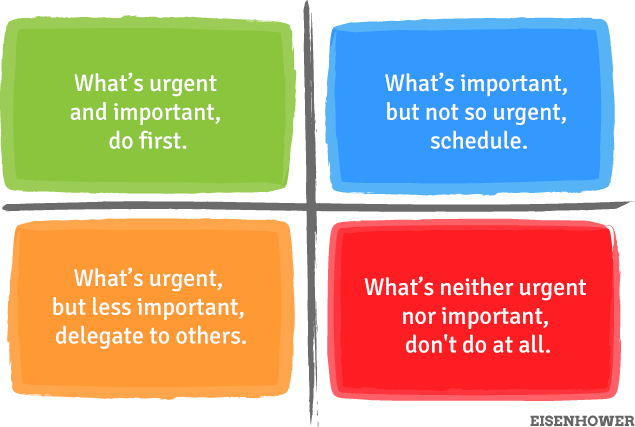I never been a fan of the Eisenhower Matrix, the what?
That’s the box that helps you figure out what’s urgent, important, important, urgent or some combination of the two words. In plainer language it helps you to figure out your priorities.
I never understood the need for it; my brain works in a simple way, complicate things too much and I switch off. For this reason I never paid any attention to Eisenhower’s big revelation.
“That which is important is rarely urgent and that which is urgent is rarely important”
You see I’ve never found prioritisation to be a problem. We all know what’s important no?
Apparently not.
After years of training and coaching people, I have realised that prioritisation continues to be major issue for many people. Getting organised and scheduling your work goes a long way towards clarity but for some it doesn’t go far enough.
So I decided to take another look at prioritisation tools and I came across Eisenhower, productivity tools for time management fans and I decided to let Eisenhower in.
Firstly Why Eisenhower?
Dwight, D. Eisenhower was the 34th President of the US. A highly regarded Army General renowned for his Time Management prowess.
.
The Eisenhower Matrix evolved around his opinion on the subject of Urgent and Important. “That which is important is rarely urgent and that which is urgent is rarely important” At least that much makes sense.
Eisenhower then suggested four quadrants; Urgent and Important, Important and not Urgent, Urgent and Not Important and Neither Urgent nor important,
This is where it became gobbledy gook to me. Anytime I would hear somebody mention Urgent and Important I would freeze up, my brain would stop working and I would switch off.
When I came across the Eisenhower website it presented the concept differently, I shifted from focusing on the words (the ones that are repeated too many times) and focused on what each quadrant represented and it finally made sense.
• Urgent /Important- Do it First
• Important/Not Urgent – Schedule it
• Urgent/Non Important – Delegate to Others
• Non Urgent/ Not important – Don’t do it at all
Important and Urgent – Do it First
Important and Urgent tasks need to be done straight away, these are tasks that need to be done today. It may be useful to use a timer to help you to focus and get the job done on time. Take a look at the Pomodoro technique. Moving forward you may want to try and plan and schedule these tasks better so that they don’t’ have to become Urgent. If these are generally tasks delegated to you by your manager, discuss it with her and suggest that next time you are given more notice so that you can schedule your work better.
Important and not Urgent – Schedule it
Important tasks are all the things that will help you get closer to your goals. This is the work that you know in advance needs to be done and should be scheduled in your calendar. In an ideal world most of your important work should reside in this quadrant but we all know that is not the case. You will often find your life goals in this quadrant. Important but never acted on. This is why the items that ended up in this zone should be scheduled and planned. No more procrastinating, time to make progress and get your goals.
Urgent and Not Important – Delegate it
This is the zone in which most of us spend most of our day. Reacting to emails, phone calls and interruptions. None of it important but all of urgent and generally other people’s priorities. Spending more time planning and scheduling your important tasks will help you to limit the amount of time and attention you give to these sorts of tasks. Your calendar will help you to prioritise your work and make better decisions around what you need to do with your time. These may also be tasks that you could delegate to others (if you are lucky enough to be in a position to delegate) or outsource to free you up for the important and urgent stuff.
Not Urgent and not important – Get Rid of It
Here reside the time wasting tasks, the types of tasks you do to avoid the Important and Urgent tasks we don’t feel like doing. Surfing the net, essential online shopping, chatting with workmates. Once you have tried using the Eisenhower Matrix once or twice, you should be able to make intuitive decisions about your work going forward. You will recognise a time wasting task and try to eliminate it more readily. You will also learn to focus on your important tasks, planning and scheduling them effectively into your day.
Unfortunately the world we live in has clouded our understanding of what constitutes urgent or important and we have come to behave like everything urgent is important and that is not the case. We can use the Eisenhower Matrix to take a step back and understand the differences between these Urgent and Important tasks.
This is the kind of exercise you should only need to do a couple of times to help you get clearer about your work and what importance should be given to it. If you are the type that needs to be hand held try out the Eisenhower app and keep what’s Urgent and important in the limelight everyday.



I’ve always thought the Eisenhower Matrix made sense but I do have trouble implementing it. I use an app called GNEO that shows your to do list in several different views, one being the Eisenhower Matrix, which I usually ignore! After reading your post I’m going to use that section a bit more!